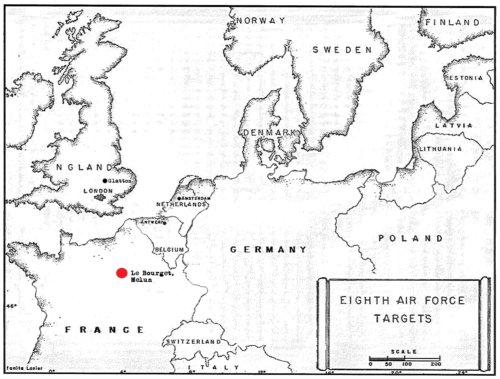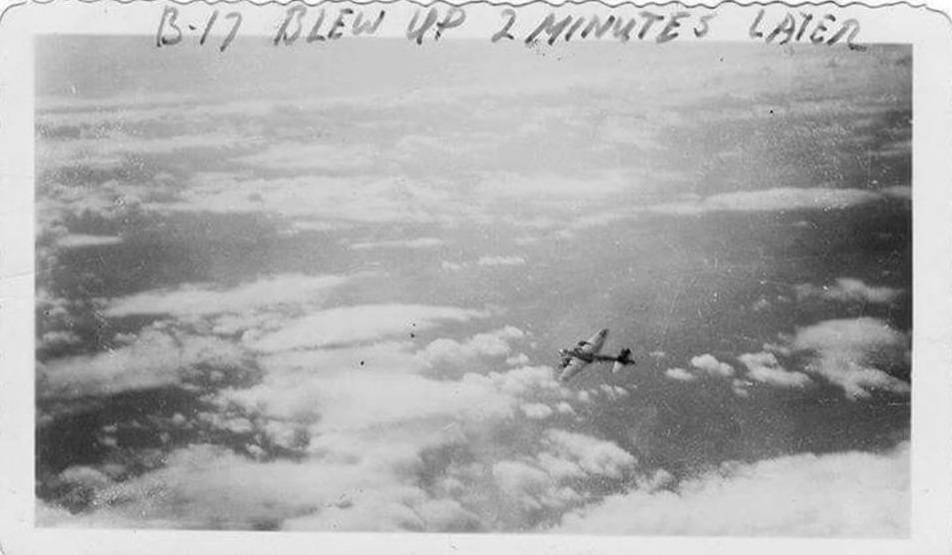TARGET: VILLAROCHE AIRFIELD
LE BOURGET, MELUN, VILLAROCHE, FRANCE
14 JUNE, 1944

Eighth Air Force reconnaissance revealed the Luftwaffe had committed a large number of fighters to the western front with principal bases to be in the larger airdromes in the Paris vicinity. Over 1500 heavy bombers were dispatched against eleven airfields in France and four in Belgium. The 457th committed sixty aircraft to the endeavor. It provided the entire 94th E Combat Wing, composed of thirty-six ships, to attack the Villaroche airfield located 20 miles southeast of Pans, near Melun. In addition, twelve ship high boxes were supplied to the 94th B and D Combat Wings, and were assigned to bomb the Le Bourget airdrome just north of Paris. Fifty-eight aircraft were airborne.
Lt. Col. Raymond L. Cobb was Air Commander of the lead E box with Lt. Malcolm E. Johnson as pilot. Major Theodore C. Hoffman led the high E box with Captain Donald E. Lady as pilot. Captain Wilbur D. Snow led the low E box with Lt. Mark R. Belcher as pilot. Major Jacob M. Dickinson led the high B box with Captain Edward B. Dozier as pilot. Major Fred A. Spencer led the high D box with Lt. Vinton H. Mays as pilot.
The 94th B Wing was third in the 1st Division formation of fourteen Combat Wings. As the Wing approached the target on the bomb run, heavy and accurate flak was encountered. The lead ship took a direct burst of flak under its tail. Just after bombs away a series of flak bursts hit the low squadron, causing serious damage to three planes.
The craft piloted by Lt. Charles R. Blackwell, on his 29th mission, was hit by a burst of flak, which knocked out three engines, caused the ship to drop out of formation and the crew to parachute from the craft.
The craft of Lt. William F. Rogers, on his 29th mission, took a burst of flak, knocking out No. 4 engine, piercing the gas tank and causing the mount of No. 3 engine to melt. The engine dropped off the plane. The craft dropped out of formation, went into a glide and the crew parachuted to the ground.
Lt. James P. LaPaze’s craft took a hit underneath the ship, remained with the formation to the English Channel, where the crew bailed out. Shortly thereafter, the ship exploded in mid- air. Four crewmen, including Lt. LaPaze, were rescued by AirL Sea Rescue.
Lt. James P. LaPaze’s B-17 before it blows up
Here is the eyewitness account of Lt. C. Overdahl: “The mission on June 14th was memorable. This trip has been described in detail by Raymond Syptak, who was flying as co-pilot and squadron commander in the lead plane that day. My perspective is that of a crewmember on a plane elsewhere in the formation. Our target was the Le Bourget airport outside Paris. The trip was uneventful to the point that some of the crew became complacent. All of a sudden without warning the engineer opened up with his double-barreled top turret guns. The burst of noise just about shattered our eardrums. We saw one German fighter make a pass at our lead plane. Our pilot shouted angry words about crewmembers not paying attention. The attack was over as fast as it started. A little while later we spotted a single parachute slowly going down. This was puzzling since we had not seen any planes go down. More puzzling was the fact that we were still heading deeper into enemy territory even though we had dropped our bombs. We were going farther and farther away from home and nobody could understand why the lead plane was not trying to get us out of France as fast as possible. Finally, we did turn around and head out.
When we got home we heard an odd story: the German fighter had hit our lead ship’s flare box that set off an extreme amount of smoke. The pilot (Lt. Gibbons) assumed they were on fire and sounded the bail out alarm for the crew to abandon ship. The enemy had knocked out the internal communication system so the crew never heard the order to jump. The copilot (Maj. Syptak) and engineer (Sgt. Birchen) crawled to the nose of the plane to jump out the escape hatch there. It was frozen shut (probably due to urine spilled from the empty ammunition cans used by the crew), so they headed for the bomb bay doors. The smoke had cleared by this time and Maj. Syptak discovered that the fire had only been from the flare box. He climbed into the pilot seat and flew the plane home. Two things had happened in the meantime: 1) the lead pilot had jumped out the bomb bay doors not knowing that the crew was still in the plane, thus explaining the single parachute; and 2) our entire group had been following the lead plane, which apparently was flying without a pilot, as we drifted further and further away from home. I have discovered that information given to us upon returning to our base differs slightly from Maj. Syptak’s account, although his version is surely the accurate one. We learned later that this pilot somehow traveled to Spain without being captured and returned to England. He was so embarrassed about abandoning his ship that he volunteered for a second tour of duty over Europe.”
As it neared the bomb run, a hit by flak started a fire in the flares behind the cockpit. The rudder control cables were destroyed and the oxygen system was out. The pilot pushed the bail out signal, and thinking all the crew were out, exited the craft through the bomb bay. The escape hatch in the nose would not open and the crew in the rear did not receive the bail out signal due to the communication system being inoperative.
Captain Raymond A. Syptak, flying as Deputy Wing Commander, took over the controls, brought the plane out of a dive, maneuvered back into position and completed the mission. On the return home a second engine went out, but he piloted the ship back to the Base. For his gallantry in action, Captain Syptak was decorated with the Silver Star. The citation which accompanied his decoration read in part: “For gallantry in action against the enemy while leading a group of B- 17 Flying Fortresses on a bombardment mission over enemy occupied territory. Just prior to reaching the target, enemy fighters made a savage attack on his aircraft, knocking out one engine, damaging a second engine and completely destroying a large number of instruments. Expertly utilizing the power of the remaining engines, Major Syptak, determined to complete the mission, maneuvered back into the lead position and continued on the bombing run”.
Over the target area, a direct flak hit destroyed the rudder control cables, punctured the oxygen supply tanks and started a raging fire inside the plane. Major Syptak ordered the crew to bail out. Unable to open the escape hatch in the nose compartment, Major Syptak, weak from lack of oxygen, struggled back to the cockpit and brought the stricken plane under control, while the engineer succeeded in extinguishing the flames. When the engineer’s clothes caught fire, Major Syptak put out the flames with his bare hands. During the return journey a second engine went out entirely, but despite this added handicap, he piloted the aircraft back to England and made a safe landing. The gallantry, indomitable fighting spirit and superior flying skill displayed by Major Syptak, undoubtedly saved the lives of the crewmen trapped in the burning aircraft.”
The engineer referred to in Captain Syptak’s citation was the flight engineer, top turret gunner, Technical Sergeant Paul A. Birchen. Working without oxygen he picked up burning flares and oxygen tanks and threw them out of the plane, ripped burning wires from a junction box and beat out flames with his flak suit until he lost consciousness from lack of oxygen. After being revived, he returned to his task of fighting the flames and labored valiantly until the fire was extinguished. He then repaired some of the damage to the rudder control cable, which contributed to the success of the return to England and for the Fortress to land safely. For his gallantry inaction, Sgt. Birchen was also awarded the Silver Star.
During the bomb run, the lead ship of the E box, piloted by Lt. Malcolm E. Johnson and with the Wing Commander Lt. Col. Cobb on board, took a direct hit by flak, zoomed up through the high squadron, then spun down out of control before exploding.
While in the process of making the 360, the craft piloted by Lt. Roy W. Allen, the third aircraft in the lead squadron, was hit by fighters, two engines were knocked out and the ship was set afire. The crew successfully bailed out except for the bombardier, who was shot in the air as he descended.
The box lead was taken over by Lt. Benny M. Flowers, but it was too late to sight and drop bombs. The low and high boxes experienced difficulty in finding the target area. The D box approached Paris after the B box. The target appeared cloud covered and a 360 degree turn was made. The same conditions existed so a target of opportunity was sought. However, on the way around Le Bourget, the target was sighted and bombed. Flak was light over the target area but at Dieppe on the way out, flak damage was encountered. A total of 27 aircraft sustained damage.
For the day, bombing results were not good and the 457th had experienced another rough mission. Lt. Charles R. Blackwell was the copilot on the Dickinson crew, one of the four original crews. He was checked out as a first pilot at Glatton and during one period flew ten missions in 17 days. With the help of the French underground he evaded capture and was liberated by advancing Allied troops. Lt. Rogers also evaded capture. Lt. Allen attempted to evade capture and lived with the French underground until~ captured. He was sent to Buchenwald as a spy and saboteur before being sent to a POW camp.
(Compiler ‘s Note: For Li. William G. Parry account of the mission, and an account of Li. Roy W Allen’s capture and experiences see Chapter 19.)
The following crews were lost on this date:
Lt Charles R. Blackwell
Lt William F. Rogers
Lt James P.LaPaze
Lt Malcome E. Johnson
Lt Roy W. Allen
